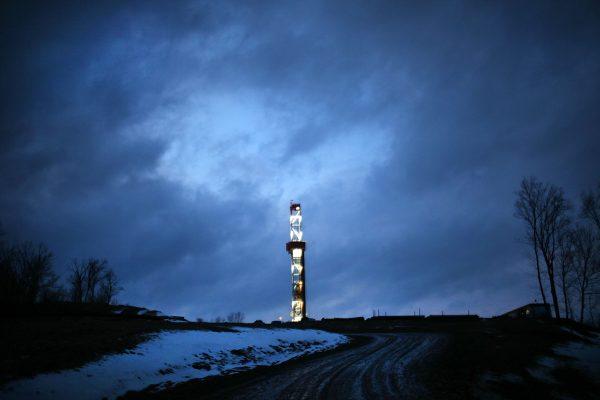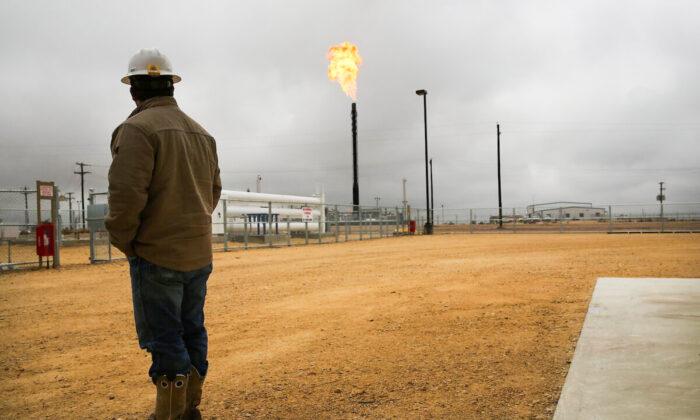Natural gas futures are trading at their highest levels in more than 13 years, with the May contract flirting with $8 per million British thermal units (Btu).
The energy commodity has been rallying on market tightness, driven by colder-than-normal weather in the United States and Europe and strong export demand amid Russia’s invasion of Ukraine.
The EIA also expects natural gas to climb by 12 percent to $4.01 in 2023.
In the week ending April 8, U.S. natural gas stockpiles rose by 15 billion cubic feet, matching market estimates. In total, inventories in storage stood at 1.4 trillion cubic feet, down by 439 billion cubic feet from the same time a year ago. Stockpiles are also 303 billion cubic feet below the five-year average.

Because of tighter inventories, market disruptions, and swelling prices, the International Energy Agency (IEA) has predicted that global natural gas consumption could tumble slightly this year. In 2021, worldwide natural gas consumption rose by 4.5 percent.
“In Asia, it is expected to grow by 3% in 2022, a marked slowdown from growth of 7% in 2021. Regions such as the Americas, Africa and the Middle East are expected to be affected less directly by gas market volatility, as they principally rely on domestic gas production. But they are nonetheless being affected by the wider economic impacts of Russia’s invasion of Ukraine including rising commodity prices, weaker purchasing power and lower investment due to dented business confidence.”
In recent weeks, Europe has accelerated its imports of U.S. liquefied natural gas (LNG) while reducing its dependence on Russia. This transition occurred at a time when storage levels were nearly one-fifth below their five-year average.
But the most effective long-term solution is to expand “energy efficiency improvements across our economies and accelerate the transition away from fossil fuels towards low-carbon sources of energy, including domestically produced low-carbon gases,” according to Keisuke Sadamori, IEA director for energy markets and security.
With Russian energy being rejected by the West, it could be a challenge to replace the supply overnight. This will result in a “significant expansion of LNG infrastructure globally,” according to Rob Thummel, a portfolio manager at Tortoise, an energy investment firm.
But coal and renewables could play a role in the near and long term, he noted.
“The best near-term solution is increased coal consumption in Asia that allows for higher volumes of LNG to land in Europe,” Thummel told The Epoch Times. “The best long-term solution for Europe, like the U.S., is an all-of-the-above approach that includes increased LNG imports from the U.S., as well as continued build-out of renewables like wind and solar and renewable fuels such as biomass.”
It’s unclear whether the United States produces enough LNG to ship greater volumes to Europe.
Before the military conflict in Eastern Europe, global LNG demand had already been skyrocketing. In February, domestic LNG exports climbed to an all-time high of 13.3 billion cubic feet per day. This represented the first time all U.S. terminals were fully docked by tankers simultaneously.
In addition, once the newest terminal in Louisiana is fully operational by the end of 2022, the total U.S. capacity will be just under 14 billion cubic feet per day.
There’s speculation that the United States could encourage Asian markets to resell American LNG to Europe.
It was recently revealed that Japan would bolster investments in LNG production to ensure that the world’s third-largest economy possesses enough supply.
Tokyo had been the world’s top LNG importer until last year, when purchases fell by nearly 4 percent. Still, Japan remained one of the largest consumers in 2021, acquiring more than 74 million tons for the year.
Today, China is now the globe’s largest buyer. Beijing increased its imports of LNG by 18 percent to a record high of 78.93 million tons last year.
Meanwhile, spring chills in the air are sending prices higher, and recent trends could justify the bullish sentiment among investors.
Any additional “bullish shocks” could significantly alter the natural gas market, Eli Rubin, a senior analyst at EBW AnalyticsGroup, wrote in a research note.
“With the natural gas market on the price-inelastic portion of the forward curve, however, even recent price gains are unable to fundamentally offset the weather-induced tightening,” Rubin wrote. “Nonetheless, with momentum firmly bullish and the market ill-equipped to handle any further bullish shocks, notable continued gains for natural gas remain likely this summer.”
Looking ahead, however, Thummel said there could be some easing in natural gas prices.
“U.S. natural gas prices likely remain elevated between $5 and $6 in the short-term due to strong global demand for natural gas,” he said. “However, in the long term, U.S. natural gas prices could fall back to the $3–$4 levels providing the U.S. a competitive advantage as a low-cost fuel that can be decarbonizing when it displaces coal.”
Natural gas futures for May rallied more than 6 percent on April 18, hitting $7.78 per million Btu on the New York Mercantile Exchange. Year-to-date, natural gas has soared by nearly 120 percent.





